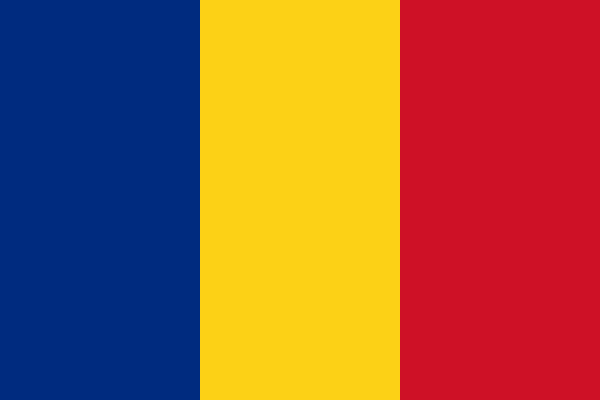 |
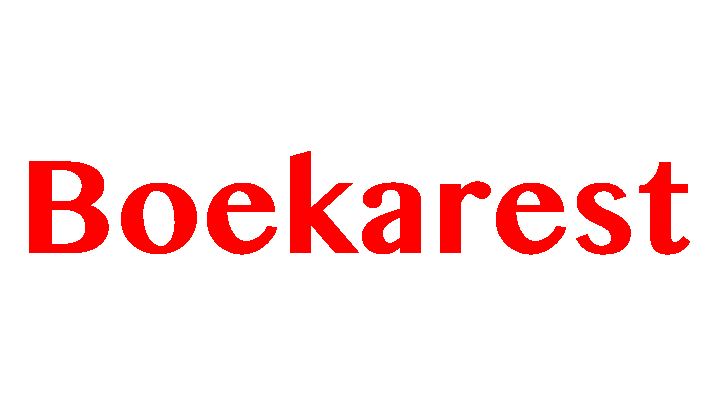 |
March 2017 |
Thursday, March 23, 2017
We left for Amsterdam Airport Schiphol last night and stayed overnight at
the CitizenM
hotel, which is a few minutes walk from the departure hall. Our flight with
KLM t o
Bucharest has to leave at 9.20 pm, but a dent has been discovered in the
tail wing and an expert has to come to assess whether we can get into
the air. Three minutes later, everything seems to be within the security
margins and we can finally leave. We will arrive 45 minutes late in
Bucharest. We are met by a taxi driver from Holiday Taxis, who we booked
through
Rent-a-guide. It's about half an
hour to the
K+K
Elisabeta hotel, close to University Square. Our room is scorchingly
hot. 30 degrees! The temperature rises to 30.5. The airco is blowing air,
but does not cool anything. The sun shining is on the big window, which can
only open slightly. We will call the reception and are told that the air
conditioning will not be repaired until next week. We ask and get a room on
the other side of the hotel, where it is about 5 degrees cooler.
o
Bucharest has to leave at 9.20 pm, but a dent has been discovered in the
tail wing and an expert has to come to assess whether we can get into
the air. Three minutes later, everything seems to be within the security
margins and we can finally leave. We will arrive 45 minutes late in
Bucharest. We are met by a taxi driver from Holiday Taxis, who we booked
through
Rent-a-guide. It's about half an
hour to the
K+K
Elisabeta hotel, close to University Square. Our room is scorchingly
hot. 30 degrees! The temperature rises to 30.5. The airco is blowing air,
but does not cool anything. The sun shining is on the big window, which can
only open slightly. We will call the reception and are told that the air
conditioning will not be repaired until next week. We ask and get a room on
the other side of the hotel, where it is about 5 degrees cooler.
After a short rest, we go into the old town for a dri nk
and a snack. We walk through the passage Macca-Vilacrosse. This is a
horseshoe-shaped passage with a yellow-colored glass roof. Today there are
restaurants and cafes with an outdoor terrace. Then we walk past the
National Military Circle palace. It was built in 1911 as a banqueting hall
for the officers association of the garrison that was stationed in
Bucharest. Now it's a cultural center of the army. It is built in French
neoclassical style. Then we go to the Orange
shop for a SIM card for
nk
and a snack. We walk through the passage Macca-Vilacrosse. This is a
horseshoe-shaped passage with a yellow-colored glass roof. Today there are
restaurants and cafes with an outdoor terrace. Then we walk past the
National Military Circle palace. It was built in 1911 as a banqueting hall
for the officers association of the garrison that was stationed in
Bucharest. Now it's a cultural center of the army. It is built in French
neoclassical style. Then we go to the Orange
shop for a SIM card for
prepaid internet. For 27 Lei we get 2 GB, which is valid for a month.
In the evening we eat at
Cara Cu Bere (beer garden), a
traditional and large restaurant in the old town. We have reserved a table
and it is very busy. Beautiful classically decorated building with lots of
wood panelling and stained glass. We eat traditional Romanian dishes, which
are quite filling and salty. To that we drink a delicious Romanian merlot
reserve. It costs a total of almost 60 euros. That really is not bad at all.
We walk back to the hotel and continue along the beautifully restored
bookstore Carturesti Carusel on the Lipscani street.
Weather: in Bucharest sunny and 16 degrees
Friday, March 24, 2017
Breakfast in the hotel is very good. After breakfast we go out for a coffee on the assumption that our guide will pick us up at
10 o'clock. It turns out to be at 9 o'clock and he calls us just when we get
our coffees. Fortunately we are close by and we are at our meeting point in
no time . We booked our guide Christi through
Tours by Locals Christi takes us to his Renault Laguna. We drive first
to the north of the city. We see the former house of Ceaucescu and then the
Arcul de Triumph. This victory arc was first raised in wood
in 1878 when Romania became independent (from Turkey). The current arch
dates back to 1922 and reminds us of Romania's conclusion of the First World
War on the winning side and the expansion of territory that came with it.
Not far from there is a statue of Charles de Gaulle. De Gaulle visited
Ceaucescu in 1968 because he did not participate in the surpression of the
Prague uprising. De Gaulle was not very impressed by the conducator. He
himself got to deal with the student revolt in Paris that year.
we go out for a coffee on the assumption that our guide will pick us up at
10 o'clock. It turns out to be at 9 o'clock and he calls us just when we get
our coffees. Fortunately we are close by and we are at our meeting point in
no time . We booked our guide Christi through
Tours by Locals Christi takes us to his Renault Laguna. We drive first
to the north of the city. We see the former house of Ceaucescu and then the
Arcul de Triumph. This victory arc was first raised in wood
in 1878 when Romania became independent (from Turkey). The current arch
dates back to 1922 and reminds us of Romania's conclusion of the First World
War on the winning side and the expansion of territory that came with it.
Not far from there is a statue of Charles de Gaulle. De Gaulle visited
Ceaucescu in 1968 because he did not participate in the surpression of the
Prague uprising. De Gaulle was not very impressed by the conducator. He
himself got to deal with the student revolt in Paris that year.
Christi points us to the red round signs on some buildings. These signs
indicate that the building has a weak structure and is not resistant to
earthquakes. The designation also states a hazard class. Bucharest lies on a
vault line is often plagued by heavy earthquakes. The last heavy earthquake
was in 1977.
Then we d rive
to the Museum
of the Village (Muzeul Satului). This is an open-air museum
with traditional farmhouses from all regions of Romania. They were broken
down and built up again here. The museum was founded in 1936 by Dimitrie
Gusti. With 300 buildings on 100,000 m2, the museum gives an idea of
Romania's farm and village life in the 19th century . After visiting the
museum we drive through the center to the old city. We look at the
Villacross Mall and then walk to the Stavropoleos church on the Lipscanist
street. The Lipscanist street is called Leipziger street after the merchants
from Leipzig who were already trading here in the 15th century. The
Stavropoleos
church dates back to 1724. There was also a monastery and an inn. The inn
and the monastery have disappeared in earthquakes and communism
respectively. Christi tells us that there are still 7 nuns living in the
monastery. We take a look at the small but
rive
to the Museum
of the Village (Muzeul Satului). This is an open-air museum
with traditional farmhouses from all regions of Romania. They were broken
down and built up again here. The museum was founded in 1936 by Dimitrie
Gusti. With 300 buildings on 100,000 m2, the museum gives an idea of
Romania's farm and village life in the 19th century . After visiting the
museum we drive through the center to the old city. We look at the
Villacross Mall and then walk to the Stavropoleos church on the Lipscanist
street. The Lipscanist street is called Leipziger street after the merchants
from Leipzig who were already trading here in the 15th century. The
Stavropoleos
church dates back to 1724. There was also a monastery and an inn. The inn
and the monastery have disappeared in earthquakes and communism
respectively. Christi tells us that there are still 7 nuns living in the
monastery. We take a look at the small but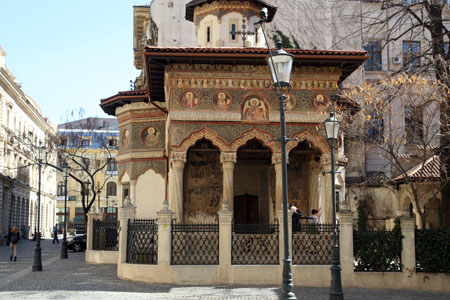 richly orthodox church.
richly orthodox church.
Then we walk to
Hanu’ lui Manuc
(Manuc's inn). This inn was built in 1808 in the form of a caravansail from
Ottoman times.
Founder was a Armenian merchant Manuc Mirzaian and was the location off the
negotiations for the Treaty of Bucharest, which ended the Russian-Turkish
war (1806-12). There is now a restaurant. Christi still has a lot of text
about everything and anything, but we get a bit full and we finish the tour.
We are going to have lunch in the courtyard of the serail. We take the set
of 29 Lei lunch (€ 5.50). Not expensive, but the food is mediocre. Then we
go back to the hotel for a rest break.
In the afternoon, we take the m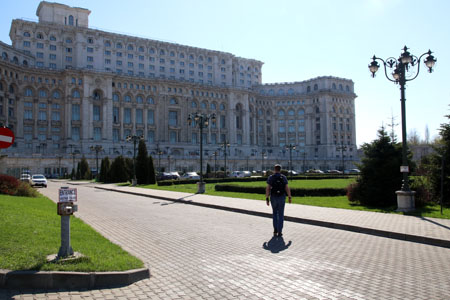 etro
to the Parliament Palace.
The metro stations are badly designed and illogically laid out, but the
metro trains are modern and Spanish built (CAF). We travel from Universitate
to Izvor Station with a transfer on Piata Unrii (Unity Square). From there
we walk through a park to Palatul Parlamentului. This is the former Palace
of the People that was created for Ceaucescu glorify communism in
Romania. The construction started in 1983, but was only completed by a
quarter during the fall and execution of the dictator. After a few years of
stagnation it has been finished. The parliament is resides here now and
international conferences are held here too. The building is the largest in
the world after the Pentagon and has more than 1,000 rooms. More than 600
architects were involved in its design and 20,000 construction workers from
all over the country worked on it. A whole district was demolished. Large
boulevards were built with
etro
to the Parliament Palace.
The metro stations are badly designed and illogically laid out, but the
metro trains are modern and Spanish built (CAF). We travel from Universitate
to Izvor Station with a transfer on Piata Unrii (Unity Square). From there
we walk through a park to Palatul Parlamentului. This is the former Palace
of the People that was created for Ceaucescu glorify communism in
Romania. The construction started in 1983, but was only completed by a
quarter during the fall and execution of the dictator. After a few years of
stagnation it has been finished. The parliament is resides here now and
international conferences are held here too. The building is the largest in
the world after the Pentagon and has more than 1,000 rooms. More than 600
architects were involved in its design and 20,000 construction workers from
all over the country worked on it. A whole district was demolished. Large
boulevards were built with  Stalinist
apartment buildings leading up to the building. We do the standard tour for
35 Lei pp. Before the tour begins, we need to undergo a safety check, which
is nothing less than an airport check. The tour runs along the main halls
and corridors. Everything is very big and richly decorated in a mix of
styles. Carpets, stairs, ceilings and walls are matched. Hundreds of
chandeliers hang in the halls and corridors, but are not all switched on.
Ceausescu and his wife interfered - not hindered by any architectural
knowledge - intensively with the construction and some staircases were taken
down twice before they were approved
Stalinist
apartment buildings leading up to the building. We do the standard tour for
35 Lei pp. Before the tour begins, we need to undergo a safety check, which
is nothing less than an airport check. The tour runs along the main halls
and corridors. Everything is very big and richly decorated in a mix of
styles. Carpets, stairs, ceilings and walls are matched. Hundreds of
chandeliers hang in the halls and corridors, but are not all switched on.
Ceausescu and his wife interfered - not hindered by any architectural
knowledge - intensively with the construction and some staircases were taken
down twice before they were approved .
It is not particularly beautiful. It is impressively large of scale. We are
also allowed on the balcony, from where Ceauscescu would like to have
spoken to his people, but he did not have the time of life. On Christmas Day
1989 he was executed. From the balcony we have the perfect aligned view of
the Unity Boulevard. After the tour, we return to the old city by subway
where we have a drink on a terrace. Then to the hotel.
.
It is not particularly beautiful. It is impressively large of scale. We are
also allowed on the balcony, from where Ceauscescu would like to have
spoken to his people, but he did not have the time of life. On Christmas Day
1989 he was executed. From the balcony we have the perfect aligned view of
the Unity Boulevard. After the tour, we return to the old city by subway
where we have a drink on a terrace. Then to the hotel.
Then we take a subway to Victory Square, where a small group of protesters
demonstrates against corruption. From here we walk to the Vinexpert
where we drink a cocktail. Then we go to
The Artist, a top notch restaurant on the
Calea Victoriei, run by a Dutch chef. We eat a delicious three course
dinner. The spoon tastings are the specialty. A grand appetizer or a grand
dessert served as a one bite dish on spoons.
After the delicious dinner take the metro back to the hotel.
Weather: sunny 17 degrees
Saturday, March 25, 2017
After b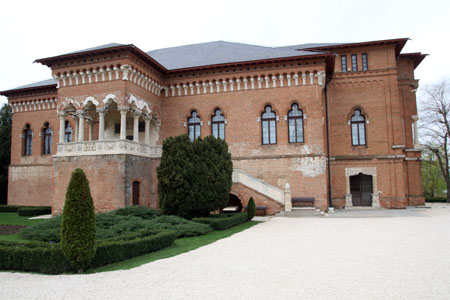 reakfast
we walk to the Intercontinental hotel, a few minutes from our hotel. There
is the AVIS branch where we pick up a rental car today. It is a Ford Fiësta
(machine). We drive out into the Mogosoaia Palace. This
18th century palace is about 10km outside the city and is beautifully
restored. It consists of a residential building, a kitchen and some
outbuildings and is on a lake. For the palace is the St George Chapel, where
an orthodox service is in progress. The church is muddy and we can not help
it anymore. Unfortunately, the palace is closed. Why is not clear. We are
inquiring at the souvenir shop. The salesman is convinced that the palace is
open, but that is not true. The door is sealed. We'll wait another 20
minutes, but at 10.20 we'll really get away. Our next destination is the
Snagov Monastery. That is north of Bucharest, about 35km fr
reakfast
we walk to the Intercontinental hotel, a few minutes from our hotel. There
is the AVIS branch where we pick up a rental car today. It is a Ford Fiësta
(machine). We drive out into the Mogosoaia Palace. This
18th century palace is about 10km outside the city and is beautifully
restored. It consists of a residential building, a kitchen and some
outbuildings and is on a lake. For the palace is the St George Chapel, where
an orthodox service is in progress. The church is muddy and we can not help
it anymore. Unfortunately, the palace is closed. Why is not clear. We are
inquiring at the souvenir shop. The salesman is convinced that the palace is
open, but that is not true. The door is sealed. We'll wait another 20
minutes, but at 10.20 we'll really get away. Our next destination is the
Snagov Monastery. That is north of Bucharest, about 35km fr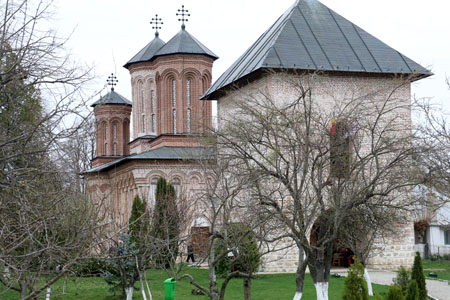 om
the palace. The monastery is on an island in a lake. It is connected by a
bridge to the shore, but not on the side of Snagov. You have to drive to
Silistea Snagovului. The monastery is no more than a small but beautiful
church. The monastery was founded by the infamous Vlad Tepes, also known as
Vlad the Spietser or Count Drucula. Vlad was ruler of Wallachije in the 2nd
half of the 15th century and delivered a lot of struggle with the Ottoman
Turks, until he was defeated by the Turks in 1476 and was killed. Vlad is
reportedly buried before the altar of this church is buried. At least,
because his headless body has been excavated for research. During our visit
to the church there is also a worship service here. There is only one
believer beside the priest and a costume, who in his beautiful voice takes
the singing.
om
the palace. The monastery is on an island in a lake. It is connected by a
bridge to the shore, but not on the side of Snagov. You have to drive to
Silistea Snagovului. The monastery is no more than a small but beautiful
church. The monastery was founded by the infamous Vlad Tepes, also known as
Vlad the Spietser or Count Drucula. Vlad was ruler of Wallachije in the 2nd
half of the 15th century and delivered a lot of struggle with the Ottoman
Turks, until he was defeated by the Turks in 1476 and was killed. Vlad is
reportedly buried before the altar of this church is buried. At least,
because his headless body has been excavated for research. During our visit
to the church there is also a worship service here. There is only one
believer beside the priest and a costume, who in his beautiful voice takes
the singing.
It's then half p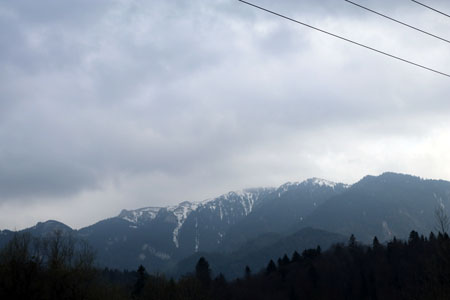 ast
12 and we're thinking about a new plan. We drive to Brasov,
which is 175km north of Bucharest. It is almost two hours drive. We eat a
pizza in a road restaurant on our way. If we reach the Carpathian mountains
after 90km, the road becomes 4 lanes, 2 lanes and becomes tortuous. The road
goes through villages and towns, including a few ski resorts. We mostly
follow a river valley. Shortly before Brasov follow a lot of hairpin turns.
At half past three we arrive in Brasov. It is bigger than we expected, but
the center is compact and well maintained. Many historic buildings,
including the black Lutheran cathedral
ast
12 and we're thinking about a new plan. We drive to Brasov,
which is 175km north of Bucharest. It is almost two hours drive. We eat a
pizza in a road restaurant on our way. If we reach the Carpathian mountains
after 90km, the road becomes 4 lanes, 2 lanes and becomes tortuous. The road
goes through villages and towns, including a few ski resorts. We mostly
follow a river valley. Shortly before Brasov follow a lot of hairpin turns.
At half past three we arrive in Brasov. It is bigger than we expected, but
the center is compact and well maintained. Many historic buildings,
including the black Lutheran cathedral .
Originally, Brasov is a German-speaking city, called Kronstadt, founded by
German ansiedler. In the 13th century, these Germans arrived at the
invitation of the Hungarian king to Transylvania to defend the country
against the Turks. The whole region of Transylvania has many of these types
of cities and is called in German Siebenburgen. The Germans are known as the
Saxony in Romania. There is little left.
.
Originally, Brasov is a German-speaking city, called Kronstadt, founded by
German ansiedler. In the 13th century, these Germans arrived at the
invitation of the Hungarian king to Transylvania to defend the country
against the Turks. The whole region of Transylvania has many of these types
of cities and is called in German Siebenburgen. The Germans are known as the
Saxony in Romania. There is little left.
We vis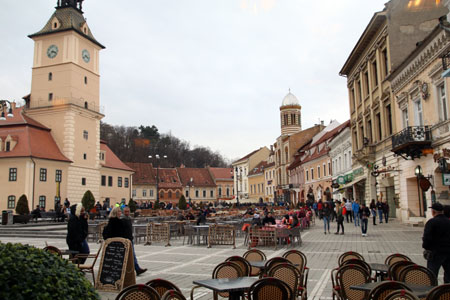 it
the black cathedral, which is from the inside of the cold,
but interestingly decorated with Turkish carpets, brought by Kronstadt
traders from Istanbul. It is a German-speaking Protestant church. The church
was built in the late 14th century and went to Lutheran doctrine in the 16th
century under the influence of Jan Honter. During a fire in the 17th century
the church was blackened - hence the name.
it
the black cathedral, which is from the inside of the cold,
but interestingly decorated with Turkish carpets, brought by Kronstadt
traders from Istanbul. It is a German-speaking Protestant church. The church
was built in the late 14th century and went to Lutheran doctrine in the 16th
century under the influence of Jan Honter. During a fire in the 17th century
the church was blackened - hence the name.
A little further down is a large square with an Orthodox church, a museum
and a former town hall. The city looks prosperous and well maintained.
We are still drinking a brasserie before we accept the return journey. The
last part of the trip is about the A3, one of the few motorways of Romania.
We return the car to Avis and have dinner at Gilda lounge. Trendy bar and
restaurant with fairly good food. Then to the hotel.
Weather: cold and cloudy. 9 degrees.
Sunday, March 26, 2017
After breakfast we take a walk through the city to Revolution Square (Piaţa
Revoluţiei). Here is the former he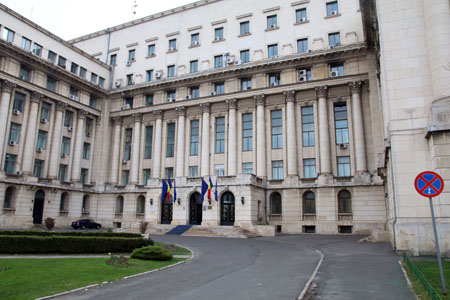 adquarters
of the Communist Party. From the balcony of this building, Nicolae
Ceaucescu gave his last speech to the people on 21 December 1989. The speech
was intended to announce increases in salaries and benefits, thus tempering
the heated moods among the people. After 8 minutes, the crowd began to push
towards building encouraged by revolutions in other East European
dictatorships in that year to the building. The square was cleared, but the
masses returned. Ceauscescu managed to escape the next day by
helicopter from the roof of the building. He was arrested and executed on
Christmas Day together with his wife Elena.
adquarters
of the Communist Party. From the balcony of this building, Nicolae
Ceaucescu gave his last speech to the people on 21 December 1989. The speech
was intended to announce increases in salaries and benefits, thus tempering
the heated moods among the people. After 8 minutes, the crowd began to push
towards building encouraged by revolutions in other East European
dictatorships in that year to the building. The square was cleared, but the
masses returned. Ceauscescu managed to escape the next day by
helicopter from the roof of the building. He was arrested and executed on
Christmas Day together with his wife Elena.
Right in  the
middle of the square is a Monument to the Rebirth. A 25 meter high pole with
a kind of wreath around it. It is also called the olive to a skewer. A
little further down is the equestrian statue of King Carol I from 2010. The
original statue of the Croatian artist Mestrovic was taken down in 1948 by
the Communists and forged into a statue of Lenin. The statue stands fin
front of the university library, which was completely looted in December
1989. About half a million books were lost. Beyond this building begins the
Piaţa Enescu, named after Romania's most famous composer. On this square is
the Ateneul
Român, Bucharest concert hall and home of the George
the
middle of the square is a Monument to the Rebirth. A 25 meter high pole with
a kind of wreath around it. It is also called the olive to a skewer. A
little further down is the equestrian statue of King Carol I from 2010. The
original statue of the Croatian artist Mestrovic was taken down in 1948 by
the Communists and forged into a statue of Lenin. The statue stands fin
front of the university library, which was completely looted in December
1989. About half a million books were lost. Beyond this building begins the
Piaţa Enescu, named after Romania's most famous composer. On this square is
the Ateneul
Român, Bucharest concert hall and home of the George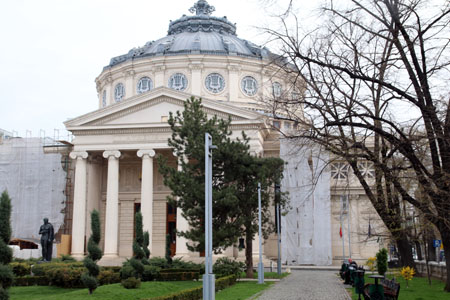 Enescu Philharmonic Orchestra. It is a neoclassical, round building with a
domed roof. It was designed by the French architect Galleron in 1888.
Enescu Philharmonic Orchestra. It is a neoclassical, round building with a
domed roof. It was designed by the French architect Galleron in 1888.
On the north side of the square is the
Athénée Hilton hotel dating back to 1912. From the 1930's
this was a hotbed of espionage. Under communism, the hotel was thoroughly
renovated in the 1950s and equipped with eavesdropping equipment. We go for
a coffee in the hotel's café. On the wall are photos of a selection of
famous international guests from top sports, art, music, film and politics.
We see pictures of Angela Merkel, Sting and many others.
After the coffee we walk back the other side of the square. We c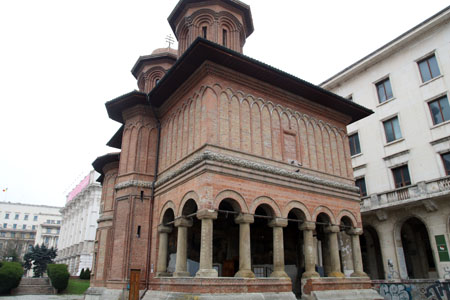 ome
past the former royal palace (Palatul Regal) from 1927. After burn down of a
simpler accommodation, King Carol II decided to make something more
prestigious. Since the 1950's it serves as the
Muzeul Naţional de Artã..
ome
past the former royal palace (Palatul Regal) from 1927. After burn down of a
simpler accommodation, King Carol II decided to make something more
prestigious. Since the 1950's it serves as the
Muzeul Naţional de Artã..
A little further down is the church Besirica Creţulescu
from 1722. Founded by nobelman Iordache Creţulescu and his wife Safta. The
church is tall and narrow with false arches. The façade consists of bricks
in jagged pattern. The church was built in the style of Brancoveanu, a ruler
from the 18th century, who established a national style for church
construction. The church we saw on the island in Snagov yesterday looks like
this, like many churches we have seen in the city. The church was heavily
damaged by an earthquake in 1940 and the riots in 1989.
We walk back to the hotel and wait for the driver to take us to the airport.
We are well on time at Henri Coanda
Airport for our flight to Amsterdam.
| Other Travel | ||